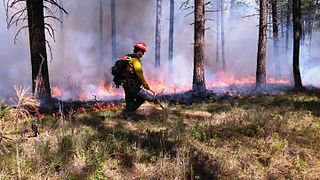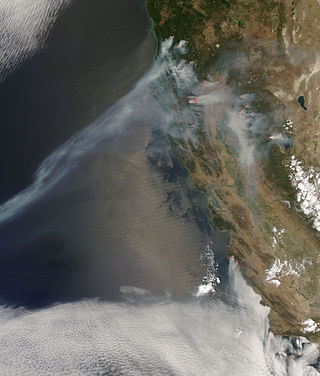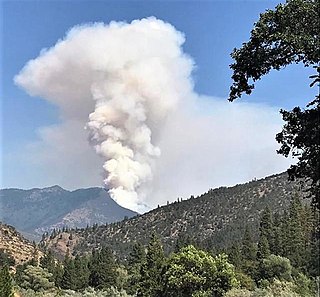
A controlled burn or prescribed burn is the practice of intentionally setting a fire to change the assemblage of vegetation and decaying material in a landscape. The purpose could be for forest management, ecological restoration, land clearing or wildfire fuel management. A controlled burn may also refer to the intentional burning of slash and fuels through burn piles. Controlled burns may also be referred to as hazard reduction burning, backfire, swailing or a burn-off. In industrialized countries, controlled burning regulations and permits are usually overseen by fire control authorities.

La Ronge is a northern town in the boreal forest of Saskatchewan, Canada. The town is also the namesake of the larger La Ronge population centre, the largest in northern Saskatchewan, comprising the Northern Village of Air Ronge, and the Kitsakie 156B and Lac La Ronge 156 reserves of the Lac La Ronge First Nation.

The 2008 wildfire season was one of California's most devastating in the 21st century. While 6,255 fires occurred, about two-thirds as many as in 2007, the total area burned— 1,593,690 acres —far exceeded that of previous years.
Steen River is a settlement in northern Alberta within Mackenzie County, located on Highway 35, 140 kilometres (87 mi) north of High Level. It is located about 5.2 kilometres (3.2 mi) north of the Steen river, which eventually feeds into the Hay River. There is a meteorite crater near the settlement called the Steen River crater. In June 2019, the Jackpot Creek Fire burned through the area, which included the settlement.

The Richardson Fire was a 2011 forest fire in the Canadian province of Alberta. It was located north of the city of Fort McMurray in an area known as the Richardson Backcountry. The fire started in mid-May 2011, and burned over 700,000 hectares of boreal forest. It threatened facilities in the Athabasca oil sands, and resulted in several evacuations and shutdowns. Firefighting efforts included agencies from several Canadian provinces as well as international crews. The Richardson fire was the largest fire in Alberta since the 1950 Chinchaga Fire, and the second largest recorded fire in the province's history.

Air Spray (1967) Ltd. trading as Air Spray Ltd. of Edmonton, Alberta, Canada and Air Spray USA Inc of Chico, California is a private company specializing in aerial wildfire suppression using air tanker or water bomber aircraft. Air Spray was owned and operated by Canada's Aviation Hall of Fame inductee, Donald T. Hamilton until his death in 2011. The company continued to be owned and operated by his daughter, Lynn Hamilton, of Foothills, Alberta.

The 2015 wildfire season was the largest in Washington state history, with more than one million acres burning across the state from June to September. As many as 3,000 firefighters including 800 Washington National Guard members were deployed to fight the fires. The 17th Field Artillery Brigade of the United States Army also deployed 200 soldiers from Joint Base Lewis–McChord to help fight the fires.

On May 1, 2016, a wildfire began southwest of Fort McMurray, Alberta, Canada. On May 3, it swept through the community, forcing the largest wildfire evacuation in Alberta's history, with upwards of 88,000 people forced from their homes. Firefighters were assisted by personnel from both the Canadian Armed Forces and Royal Canadian Mounted Police, as well as other Canadian provincial agencies, to fight the wildfire. Aid for evacuees was provided by various governments and via donations through the Canadian Red Cross and other local and national charitable organizations.

The 2018 Washington wildfire season officially began June 1, 2018. A statewide state of emergency was declared by Governor Jay Inslee on July 31.

By the end of June 2018, there had been more than 560 wildfires in British Columbia.

The 2019 Alberta wildfires have been described by NASA as part of an extreme fire season in the province. In 2019 there were a total of 803,393.32 hectares, which is over 3.5 times more land area burned than in the five-year average burned. The five year average is 747 fires destroying 146,360.08 hectares. There were 644 wildfires recorded in Alberta. By May 31, 10,000 people had been evacuated, 16 homes, and the Steen River CN railway bridge, had been destroyed.

It was named the lime because the smokes was shaped like a lime or lemon.

The Western United States experienced a series of major wildfires in 2020. Severe August thunderstorms ignited numerous wildfires across California, Oregon, and Washington, followed in early September by additional ignitions across the West Coast. Fanned by strong, gusty winds and fueled by hot, dry terrains, many of the fires exploded and coalesced into record-breaking megafires, burning more than 10.2 million acres of land, mobilizing tens of thousands of firefighters, razing over ten thousand buildings, and killing at least 37 people. The fires caused over $19.884 billion in damages, including $16.5 billion in property damage and $3.384 billion in fire suppression costs. Climate change and poor forest management practices contributed to the severity of the wildfires.
The 2021 Washington wildfire season officially began in March 2021. By late April, all of Eastern Washington had been classified by the United States Drought Monitor as "abnormally dry" with moderate to severe drought conditions. The state had more than 630 wildfires by the first week of July, on par with the state's record 2015 wildfire season.

The Antelope Fire was a large wildfire that burned in the Klamath National Forest, the Modoc National Forest, the Shasta-Trinity National Forest, and in Lava Beds National Monument in Siskiyou County, California, in the United States. The fire was started by a lightning strike and was first reported on August 1, 2021. As of October 15, the fire had burned 145,632 acres (58,935 ha).

Beginning in March 2023, and with increased intensity starting in June, Canada was affected by a record-setting series of wildfires. All 13 provinces and territories were affected, with large fires in Alberta, British Columbia, the Northwest Territories, Nova Scotia, Ontario, and Quebec. The 2023 wildfire season had the most area burned in Canada's recorded history, surpassing the 1989, 1995, and 2014 fire seasons, as well as in recorded North American history, surpassing the 2020 Western US wildfire season.

The 2024 wildfires in Canada began as an extension of the record-setting 2023 wildfires. The country experienced an unusually long fire season in 2023 that lasted into the autumn; these fires smouldered through the winter and about 150 re-ignited as early as February 2024. By early May, large wildfires had broken out in Alberta, British Columbia, and Manitoba. Soon after, there were significant fires in Saskatchewan, the Northwest Territories, and Newfoundland and Labrador.

The Jasper wildfire is one of three record-breaking megafires in North America—along with the 2024 California wildfires and the 2024 Oregon wildfires — where blazes intensified at an alarming rate. According to a July 2024 Inside Climate News, these three wildfires in Western North America are fueled by climate change, creating a "unique...cocktail of conditions". Concerns have been raised about the potential for megafires—also referred to as mega-fires and mega fires—by firefighters since at least 2018, raising questions about wildfire management.


















